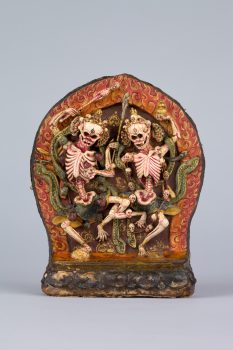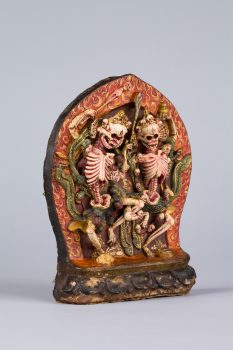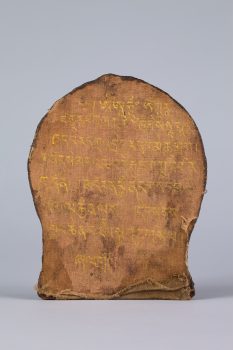Tibet
18th century



Tibet
18th century



FRONTThese skeleton lords of the charnel ground are animated by ecstatic dance and laughter, their festive demeanor expressing the joy of being free from attachment. They are brother and sister, and the male and female figures can be distinguished only by their garlands and attributes. The male sports a garland of freshly severed heads and holds a skeleton club and a skull bowl. The female, in contrast, wears a garland of dried skulls and holds a staff and a golden vase. They support the practice of the deity Chakrasamvara and are revered as powerful protectors.BACKThe text on this work, written on cloth and attached to the piece, begins with the specific mantra of the lords of the charnel ground and then evokes the protective function of the couple:“Eliminate misery from harmful spirits, fire, water, and lightning, the perseverance of ill-will, robbery, thievery, and harmful underground and earth spirits; in short protect from outer, inner, and secret adverse conditions from today until attaining great awakening.”
One of the main sources of suffering in the endless cycle of death and rebirth known as samsara. Buddhists regard offering protection from fear as an act of compassion or form of giving.
The end of this life marked by the cessation of bodily functions followed by decay. According to Buddhism, after death consciousness transitions to an intermediate state known as the bardo before embarking on another life.
Prescribed practices that carry symbolic meaning and value within a specific tradition and are intended to attain a desired outcome. Rituals are usually done as part of a ceremony or regular routine.
Today, Tibetans primarily inhabit the Tibetan Plateau, situated between the Himalayan mountain range and the Indian subcontinent to the west, Chinese cultural regions to the east, and Mongolian cultural regions to the northeast. During the 7th to 9th century, Tibetan rulers expanded their empire across Central Asia, and established Buddhism as the state religion.
Get the latest news and stories from the Rubin, plus occasional information on how to support our work.